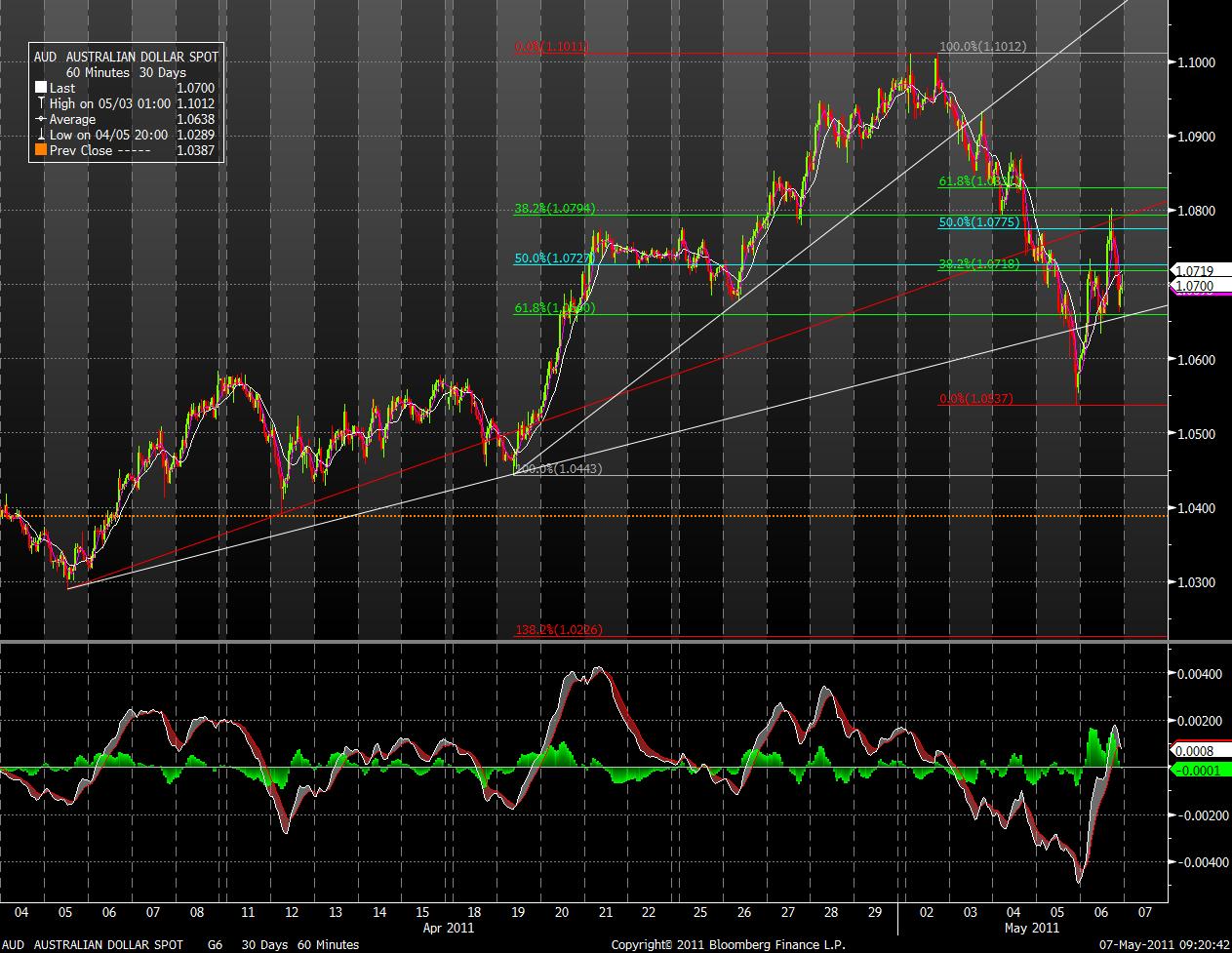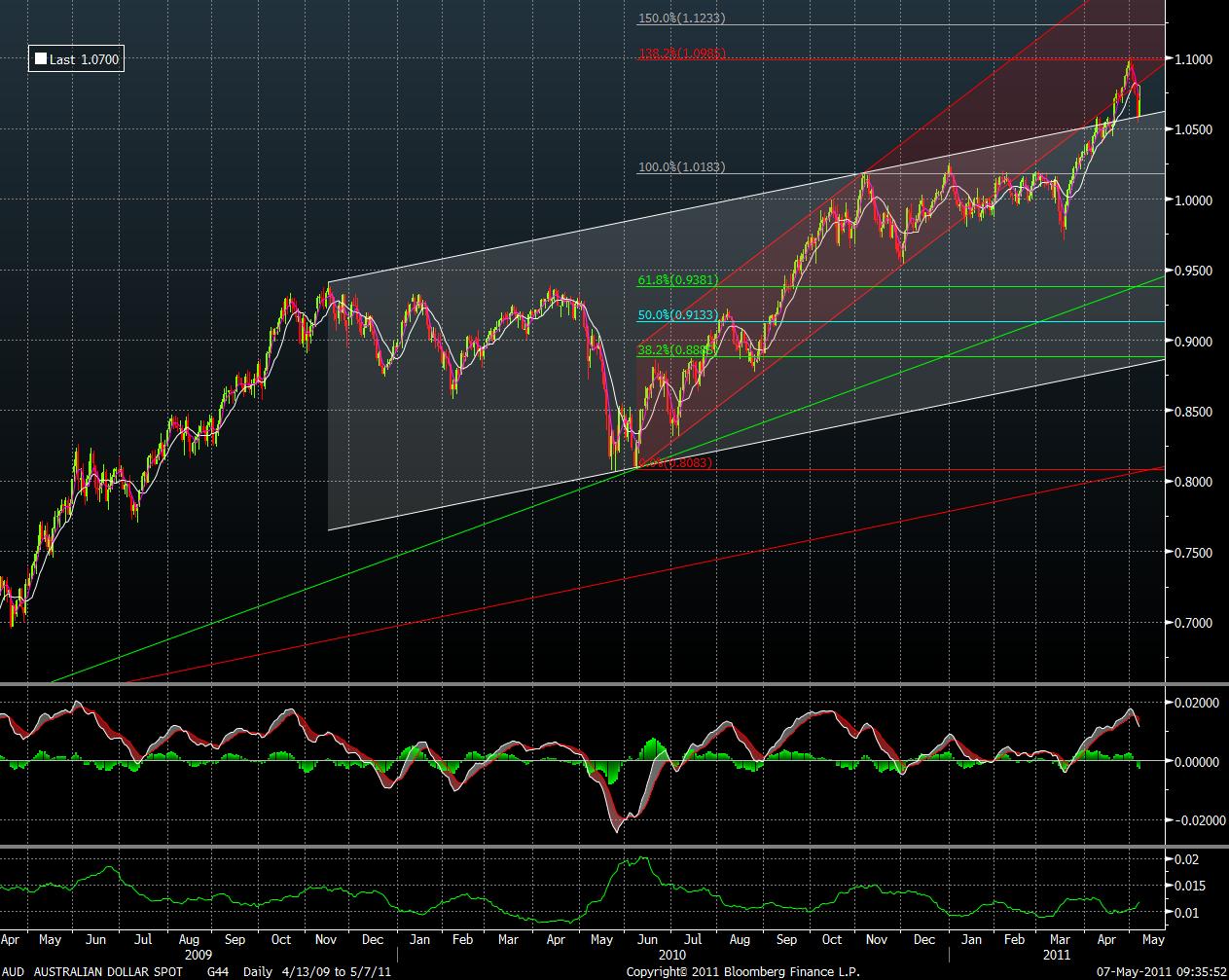
Those of you not heavily involved in currency markets probably wonder about their stability after a week where the Aussie made post float high at 1.1013 and then promptly fell to a low of 1.0537 before closing at 1.07. But that is life in currency land and it wasn’t just the Aussie that saw such volatility.
Many currencies and commodities fell hevily against the USD as it seemed that the death of OBL gave the USD a lift across the board. Oil fell $10 bbl at one stage during the week and reports that Greece might drop the EUR saw the single currency close the week at 1.4316 after a high during the week of 1.4943, down 4.21%.
So it was a week were the USD found some support but individual country and currency specific factors also helped.
On the Aussie the serendipitous combination of techncals and a stretched fundamental envelope saw it reject the 1.1014 region I identified earlier in the week. So at the end of a tumultuos week it is worth updating my view on the AUD after some fortuitous timing earlier in the week to call the ding dong high and because my first target of a move to 1.07 was achieved so easily.
First of all it is important to say that based on the technicals the AUD should be heading all the way back to where this move started at 1.0443 but it needs to close below 1.0580/85 to signal a much deeper move.
Lets look at the hourly chart first.

We can see that it had a deep move to 1.0537 and then expectations about a hawkish RBA saw it bid in Asian trade yesterday. For currency traders and interest rate strategists these expectations seemed to have been supported by the SoMP (although I’m not convinced that this is the case) and the Aussie rallied to a high overnight of 1.0805.
Now an almost 3 cent bounce is a good bounce with plenty to be made or lost depending which side you are on. But in technical terms it looks like a 3 wave correction of the initial down move (Ellioticians over to you) and still below the maximum Fibonacci move I would have been looking for. I would have sold in the 1.0710/75 zone with a stop above the 61.8% retracement at 1.0829 and still expected it to go lower.
Now I am wary of getting too bearish given the longer term 5 drivers remain supportive and particularly because the market has taken the RBA so hawkishly. But the technicals are the technicals and both the Aussie and the USD index look like they may have turned in the past few days.
To this end I really liked a piece by ANZ FX Strategist Tim Riddell, which came across my desk this week, where he looked at the current pessimistic crescendo (my term not his – I coined it in March 2009 when we called the Equity low) in sentiment toward the USD:
MEMORIES OF 1995: LOVE TO LOATHE USD
Fear and loathing
Whenever consensus drives criticism into hiding it should concern markets. Both hubris and pride come before a fall. The near universal sentiment towards USD may therefore be at a dangerous stage. Reasons for loathing USD seem to have been vindicated by soft US data and the Fed’s willingness to leave the liquidity tap on full bore. I now fear that this hatred towards USD is approaching levels that developed in 1995. After an initial focus on why current loathing has gained pace and some intriguing (for me at least) comments from the ECB on USD, the focus turns to a series of similarities between current conditions and those in 1995.Of course, the current environment is considerably different in many
aspects. History may not repeat itself exactly, but markets appear to be
dancing to a similar tune. The purpose of this article is to raise debate over
whether the consensus on USD weakness is to remain a structural theme, or
whether a potentially sharp counter cycle USD rebound is about to occur…The USD is now loathed as it was in 1995.
Of course “it is different this time.” The global economy has become materially different over the past 15 years as China has entered and embraced the global economy. The unprecedented global downturn, triggered by the credit crises in the North Atlantic region, was met by unprecedented, coordinated action. This has resulted in further unprecedented paths of recovery (led by the East) and the adoption of unprecedented policy in the US (and UK). The consequences of these actions are largely unknown even before we address how the liquidity provisions will be unwound. The level of debt left in the hands of the financial systems and governments of the North Atlantic region hugely exceed the problems faced by global markets in 1995, when Greenspan ruled the Fed and Robert Rubin became US Treasury Secretary.
This is the big question for currency and commodity traders because the USD is on the other side of so many of these values. Aussie, EUR, Oil, Gold, Copper and so on. They are all denominated in USD’s one way or another and so, leaving aside natural supply and demand, their price moves with the moves in the USD.
So if the USD has turned, or is turning, it is really important for the trend and or the reversal of same.
Tim Looks at the parallels between 1995 and now and says of the USD:
I can almost smell the similar level of disdain for USD and the power of the crowd to dismiss any countering of that view. Consequently, I am drawn to a series of parallels that occurred in 1995 to current events which are listed below:
Parallel times
1995: Democratic President Clinton had lost his majority in Congress at the mid-term elections and was embroiled in budget battles.
2011: Democratic President Obama has lost his majority in Congress at the mid-term elections and was embroiled in budget battles.
1995: The Clinton administration struggled to gain support for an overhaul of the medical/health system that was eventually dropped.
2011: The Obama administration struggled to gain support for an overhaul of the medical/health system…resulting in a much reduced plan.
1995: The fiscal scenario led to a downgrading of US’ AAA rating to negative watch (in 1996)
2011: The fiscal scenario led to a downgrading of US’ AAA rating to negative watch in 2011
1995: The troubled housing sector and its bankrupt financing (S&L) was a major drag on US recovery from the recent recession in 1995. The Resolution Trust Company managed the failures until it was changed to the SAIF in 1995.
2011: The troubled housing sector and its bankrupt financing was a major drag on US recovery from the recent recession in 2011. The failed and troubled banks were saved by TARP, major banks had repaid much of the bailout support in 2011.
1995: Europe was recovering from a crisis in confidence in ERM during 1992-1993 with a series of sovereign departures that risked ripping moves to a common currency apart.
2011: Europe is recovering from a crisis in confidence in EURO that was created by a series of sovereign debt crises that risked ripping the common currency apart.1995: Japan suffered a dramatic earthquake (Kobe) that, after a sharp increase in value, changed sentiment towards JPY.
2011: Japan suffered a massive earthquake that has altered sentiment towards JPY after a sharp increase in value.
1995: G-7 engaged in concerted, multilateral intervention to support USDJPY and avoid a potential downward spiralling of USDJPY and dislocation of markets more widely.
2011: G-7 engaged in concerted, multilateral intervention to support USDJPY and avoid a potential downward spiralling of USDJPY and dislocation of markets more widely.
1995: Non-Japan economies were seen as impervious and on a rising trajectory backed by capital flows (Tiger economies).
2011: Non-Japan economies were seen as impervious and on a rising trajectory backed by capital flows (all AXJ economies, notably China).
1995: USD was seen to be in a severe downward trend from which there seemed no respite. Several currencies were moving to all time highs against the weakening greenback. Even US bulls were forced into compliance with the USD’s downtrend and its loss of reserve value (to be replaced by JPY and the forthcoming formation of EUR).
2011: USD is seen to be in a severe downwards trend from which there seemed no respite. Several currencies were moving to all time highs against the weakening greenback. Even US bulls were forced into compliance with the USD’s downtrend and its loss of reserve value (to be replaced by EUR and the forthcoming globalisation of CNY).
1995: US assets, particularly US treasuries, were seen at risk of liquidation from the huge holdings held by Asian CB’s (notably Japan).
2011: US assets, particularly US treasuries, were seen at risk of liquidation from the huge holdings held by Asian CB’s (notably China).
(On currency divergence)
1995: USDDEM was making a series of materially lower lows whilst USDCHF was lagging
2011: USDCHF is making a series of materially lower lows whilst EURUSD is lagging.The USD made a major cyclical turn by mid-1995 and then rallied for six years.
Now there are many ways you can argue with this analysis if you want to. But as Tim points out for the USD and by implication the Aussie and commodities, the key is there is already a lot of bad news and bad karma priced in and it would probably require another material down leg in the outlook for the US economy for fresh impetus to enter into the short USD trade.
As Tim concludes,
The reasons for selling USD have been apparent for some time. The rationale has gained a surge of interest in the past six weeks.
Of course it is ‘different this time’, but there are also some marked similarities between 1995 and the current environment. Long-term trends always look likely to extend when the approach a turn, especially when the trend has been dynamic.
The frenzy of risk appetite could be impaired as tightening across Asia achieves one of its goals: moderating growth. Recent shifts in equities and commodities may just be interim moves, but may also augur the end of the love of loathing for USD.
Rather than increase positioning into further USD weakness, protection ought to be sought.
The technicals for the Aussie and the resistance at 1.1014 concur that caution is best warranted at the moment at these historically heady levels.
In the short term this daily chart shows that a close below 1.0580/85 will open the way for a deeper move inside the old up channel. Importantly for those of us with a Fibonacci bent the high this week was only 30 points through the 138.2% projection of the June-November 2010 move before the months of consolidation which reinforces this zone as a top.
It’s been a big week, an all time high at significant resistance and an almost 5 cent pullback in the space of 4 days. It would be usual for the market to bounce a little and consolidate. Overall I expect a move toward 1.0440 to retrace this entire recent up leg and then we’ll have a look there.
If Tim Riddell is right about the USD and the technicals give room for this then we could see a move into the 1.01/2 region where very solid support will likely exist given the still strong 5 drivers. Equally as we saw overnight it might be time for Aussie rotation and strength against the non-Yen crosses as the USD appreciates.
